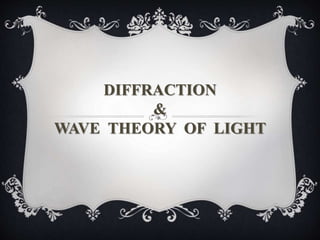
Diffraction and wave theory of light
- 1. DIFFRACTION & WAVE THEORY OF LIGHT
- 2. DIFFRACTION INTRODUCTION: Diffraction is the phenomenon that occurs when waves bend around objects; specifically when passing through a gap and spreading out at the end. Francesco Maria Grimaldi an Italian scientist was the first to observe and identify this phenomenon.
- 6. WAVE THEORY OF LIGHT
- 7. According to particle nature of light that was presented by Newton. Newton said that light is actually in the form of small packets. Newton generally said particles to these small packets. And the light are in the form of particles, and he named it corpuscles. And corpuscles are also known as particles of light. Newton said that the nature of light is corpuscular and the particles of light are travel in the form of packets. This known as corpuscular theory.
- 8. After this a physics scientist HUYGEN’S comes and he presented that the light are in the form of wave. It is not in the form of particles. We have two forms in which object travel, First one “The object travel in the form of wave” that is the theory of HUYGEN’S, Second one is that “The objects travel in the form of packets or corpuscles” which is the theory of Newton.
- 9. Physics presntation Presenting team Abdullah Adnan sher Ijaz ahmad Hassan farooq Muhammad abbas
- 10. Carpuscular theory which is the theory of newton that was rejected because it includes some points that are wrong after sometime. Huygens presented that the light travel in the form of waves. According to the physicians whenever any wave moves, it required a medium to travel from place to another. Such as:
- 11. Water waves its medium is water because water waves travel on water. Sound waves its medium is Air, Solid and Liquid because sound waves cannot move without these mediums
- 12. So when light presented in the form of waves so physicts said that in universe all space around us their exist a medium that named as “AETHER”. In the Aether a light waves travel. Without this medium a light wave cannot move.
- 13. In figure we showed light in the form of waves. Huygens presented his theory that light can travel in the form of wave, Not in the form of particles so for the support of Huygens theory the best evidence is interference phenomenon.
- 14. Interference of light: “The process in which two or more light, or electromagnetic waves of the same frequency combine to reinforce or cancel each other, the amplitude of the resulting wave being equal to the sum of the amplitudes of combining waves.” Interference have two types :
- 15. Constructive interference: When two waves meet in such a way that their crests line up together, then it's called constructive interference. The resulting wave has a higher amplitude. Destructive interference: when the crest of one wave meets the trough of another, and the result is a lower total amplitude
- 16. The phenomenon of interference doesn’t occur in particles because it is general property of wave. Diffraction and interference are those properties which only occur in waves. When light observed interference phenomenon so from it is proved that the light is actually in the form of waves , not in particles form. And this experiment was done by THOMAS YOUNG . so THOMAS YOUNG supported the HUYGEN’S THEORY.
- 17. Another scientist “MAXWELL” proved that the light is actually the form Electromagnetic waves and speed of light is equal to the speed of electromagnetic waves and it is denoted by “C”. and its value is 3 x 10^8 m/s in the vaccum And its speed is different in different medias.
- 18. So it is the theory that presented HUYGENS against NEWTON that the light travels in the form waves , not in the form of particles form Huygens presented this theory and other scientists proof it that the light are in the form of wave
- 19. LIGHT WAVE THEORY Light can exhibit both a wave theory, and a particle theory at the same time. Much of the time, light behaves like a wave. Light waves are also called electromagnetic waves because they are made up of both electric (E) and magnetic (H) fields. Electromagnetic fields oscillate perpendicular to the direction of wave travel, and perpendicular to each other. Light waves are known as transverse waves as they oscillate in the direction traverse to the direction of wave travel.
- 21. WAV E S H AV E T W O I M P O R T A N T C H A R A C T E R I S T I C S - WAV E L E N G T H A N D F R E Q U E N C Y. Wavelength: This is the distance between peaks of a wave. Wavelengths are measured in units of length - meters, When dealing with light, wavelengths are in the order of nanometres (1 x 10-9 ) Frequency: This is the number of peaks that will travel past a point in one second. Frequency is measured in cycles per second. The term given to this is Hertz (Hz) named after the 19th century discoverer of radio waves - Heinrich Hertz. 1 Hz = 1 cycle per second
- 22. HUYGENS PRINCIPLE Huygens’s Principle states that every point on a wavefront is a source of wavelets. These wavelets spread out in the forward direction, at the same speed as the source wave. The new wavefront is a line tangent to all of the wavelets.
- 24. FIGURE OF WAVE THEORY RELATING TO DIFFRACTION:
- 25. Thank you